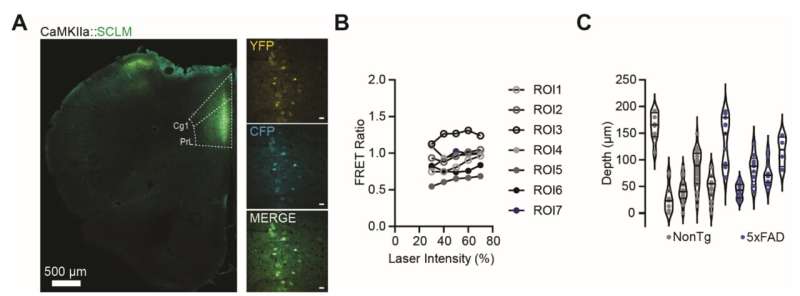This article has been reviewed according to Science X's editorial process and policies. Editors have highlighted the following attributes while ensuring the content's credibility:
fact-checked
peer-reviewed publication
trusted source
proofread
A therapeutic target for Alzheimer's disease discovered

Scientists at Université Laval and the University of Lethbridge have succeeded in reversing certain cognitive manifestations associated with Alzheimer's disease in an animal model of the disease. Their results have been published in the scientific journal Brain.
"Although this has yet to be demonstrated in humans, we believe that the mechanism we have uncovered constitutes a very interesting therapeutic target, because it not only slows down the progression of the disease but also partially restores certain cognitive functions," comments study leader Yves De Koninck, a professor in the Faculty of Medicine and researcher at Université Laval's CERVO research center.
Previous studies have shown that even before Alzheimer's symptoms appear, brain activity is disrupted in people who go on to develop the disease. "There is neuronal hyperactivity and signal disorganization in the brain. Our hypothesis is that a mechanism that regulates neuronal activity, more specifically the one responsible for inhibiting neuronal signals, is disrupted," explains the researcher.
"The main inhibitor of neuronal signals in the human brain is the neurotransmitter GABA. It works in close collaboration with a cotransporter, KCC2. This is an ion pump, located in the cell membrane, which circulates chloride and potassium ions between the inside and outside of neurons," recalls Professor De Koninck. Maintaining this ion pump in the neuron's cell membrane could slow down or reverse the pathology.
"A loss of KCC2 in the cell membrane can lead to neuronal hyperactivity. One study has already shown that KCC2 levels were reduced in the brains of deceased Alzheimer's patients. This gave us the idea of examining the role of KCC2 in an animal model of Alzheimer's disease," adds the researcher.
Promising results in mice
To do this, scientists used mouse lines expressing a manifestation of Alzheimer's disease. The researchers found that when these mice reached the age of four months, KCC2 levels decreased in two regions of their brains: the hippocampus and the prefrontal cortex. These two regions are also affected in people suffering from Alzheimer's disease.
In light of these results, the researchers turned to a molecule developed in their laboratory, CLP290, a KCC2 activator that prevents its depletion. In the short term, the administration of this molecule to mice that already had reduced KCC2 levels improved their spatial memory and social behavior. In the long term, CLP290 protected them against cognitive decline and neuronal hyperactivity.
"Our results do not imply that the loss of KCC2 causes Alzheimer's disease," insists Prof. De Koninck. "On the other hand, it does appear to cause an ionic imbalance leading to neuronal hyperactivity that can lead to neuronal death. This suggests that by preventing the loss of KCC2, we could slow down and perhaps even reverse certain manifestations of the disease."
For various reasons, CLP290 cannot be used in humans. Professor De Koninck's team is searching for other KCC2-activating molecules that would be well tolerated by Alzheimer's sufferers.
"We have developed new molecules which are currently being evaluated in our laboratory. In parallel with this research, we are testing drugs that are used for purposes other than Alzheimer's in humans, in order to assess their effects on KCC2. Repositioning an existing drug would accelerate work on this new therapeutic avenue," emphasizes the researcher.
More information: Iason Keramidis et al, Restoring neuronal chloride extrusion reverses cognitive decline linked to Alzheimer's disease mutations, Brain (2023). DOI: 10.1093/brain/awad250





















